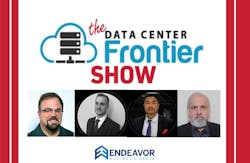DCF Show: Microreactor vs. SMR Pros and Cons for Data Centers with Nano Nuclear Energy
For this episode of the Data Center Frontier Show podcast, DCF's editors sat down with James Walker, BEng, MSc, CEng, PEng, CEO and board member of Nano Nuclear Energy Inc., and Jay Jiang Yu, Nano Nuclear Energy's founder, executive chairman and president, for a discussion regarding industry news and technology updates surrounding small modular reactor (SMR) and microreactor nuclear onsite power generation systems for data centers.
James Walker is a nuclear physicist and was the project lead and manager for constructing the new Rolls-Royce Nuclear Chemical Plant; he was the UK Subject Matter Expert for the UK Nuclear Material Recovery Capabilities, and was the technical project manager for constructing the UK reactor core manufacturing facilities. Walker has extensive experience in engineering and project management, particularly within nuclear engineering, mining engineering, mechanical engineering, construction, manufacturing, engineering design, infrastructure, and safety management. He has executive experience in several public companies, as well as acquiring and re-developing the only fluorspar mine in the U.S.
Jay Jiang Yu is a serial entrepreneur and has over 16 years of capital markets experience on Wall Street. He is a private investor in a multitude of companies and has advised a magnitude of private and public company executives with corporate advisory services such as capital funding, mergers and acquisitions, structured financing, IPO listings, and other business development services. He is a self-taught and private self-investor whose relentless passion for international business has helped him develop key, strategic and valuable relationships throughout the world. Yu leads the corporate structuring, capital financings, executive level recruitment, governmental relationships and international brand growth of Nano Nuclear Energy Inc. Previously, he worked as an analyst as part of the Corporate & Investment Banking Division at Deutsche Bank in New York City.
Here's a timeline of key points discussed during the podcast:
0:22 - Nano Nuclear Energy Expert Introductions
1:38 - Topic Set-up Re: DCF Senior Editor David Chernicoff's recent data center microreactor and SMR explorations.
1:59 - How microreactors might impact the data center industry. (Can time-to-market hurdles be shrunk?)
2:20 - Chernicoff begins the interview with James and Jay. How the NuScale project's difficulties in the SMR segment resulted in the DoD pulling back on preliminary microreactor contracts in Alaska due to market uncertainties directly related to NuScale.
3:23 - Perspectives on NuScale and nuclear power.
4:21 - James Walker on NuScale vs. microreactor prospects:
"They have a very good technology. They're still the only licensed company out there, and they probably will bounce back from this. It's not good optics when people are expecting product to come out of the market. And NuScale was to be the first, but market conditions and the structure of SPACs and the lack of us infrastructure can all complicate what they want to do. Half the reason for them taking so long is because the infrastructure was not in place to support what they wanted to do.
But even hypothetically, even if the SMR market, as an example, was to collapse, microreactors are really targeting a very different area of market. SMRs are looking to power cities and big things like that. Microreactors, you're looking at mine sites, charging stations, free vehicles, disaster relief areas, military bases, remote habitation, where they principally fund all their energy using diesel. It's kind of hitting a different market. So even if the SMR market goes away, there's still a huge, tremendous upside, potential untapped market in the microreactor space."
5:39 - DCF Editor in Chief Matt Vincent asks, "What's the pros and cons of the prospects for microreactors versus what we're commonly thinking about in terms of SMR for data centers?"
5:51 - Nano Nuclear's James Walker responds:
"I would start with the advantages of microreactors over SMR. It's smaller, it'll be cheaper, it'll be safer, it'll be more deployable, you'll have far more economies of scale of producing hundreds of these things. They're easier to decommission, remove, they're easier to take apart.
I mean, logistically, shipping these things around the world as if they were diesel generators is a very feasible prospect. Opex cost will be far lower. Personnel that need to be involved in the day to day physical operation will be negligible.
Where the disadvantage of a microreactor is, is that SMRs would provide a cheaper form of electricity. But as SMRs are providing for cities, microreactors are more for remote locations, remote industrial projects, remote data centers, those kind of things.
You're really competing with sort of the high costs of remote diesel.
As an example, we were speaking with some Canadian government officials and they were saying [with] some of their remote habitations, they can have a community of 800 people, but it still costs $10 million US in fuel alone, ignoring all of the logistical costs of bringing that fuel in on a daily basis, just to power those remote communities that have no possibility of being hooked up to a grid because it's too far.
And that would be the same for all sorts of things, like if you want a remote data center, remote or mining operations, remote industrial projects, oil and gas things, then microreactors aren't really competing with SMRs on cost."
7:33 - Data Center Frontier's David Chernicoff asks:
"We're a data center publication, so that obviously is a lot of interest to us, and you pointed out how diesel is the primary methodology for backup power for data centers.
I realize no one has actually shipped a microreactor yet in this form factor. But one of the advantages, for example, that comes from Project PELE from the US DoD was the decision to standardize on Tristructural Isotropic (TRISO) fuel so that for anybody building one, now, the whole issue of building infrastructure to provide the fuel is significantly simplified.
Realistically (and obviously we're asking you to make a projection here, but), when you're able to deliver microreactors at any sort of scale, will they be competitive with diesel generators in the data center space? And I would also allow for you to say, well, diesel generators also have to deal with all the emissions issues, environmental concerns, greenhouse gases, et cetera, that are not issues with a containerized nuclear power plant. So will there be a realistic model there?"
8:45 - James Walker compares the financing costs of diesel generators vs. microreactors.
9:28 - Walker offers this forecast:
"With competing with diesel generators, once the infrastructure [for nuclear] is built back up, and you have deconversion facilities and enrichment facilities able to produce High-Assay Low-Enriched Uranium (HALEU) fuel, and companies are able to source this stuff very readily, the capital costs come down markedly. And that'll be the same for people like NuScale. Then there'll be an optimization period, typically, I would expect over an eight-year period of launch. So, say microreactors launch in 2030, nearing 2040, I believe the cost will be competitive with diesel by that point. Because the optimization will kick in, the infrastructure will all be in place. And the economies of scale over which these things are being produced means that, yes, you'll essentially have a nuclear battery that can compete with diesel, that can give you 15 years of clean energy, at a cheaper rate. That's what the projections show currently."
10:31 - Discussion point clarifying that nuclear microreactors for battery backup are being positioned for replacement of diesel generation, as distinct from SMR power plant options.
12:00 - Walker explains how the power range of microreactors can vary. SMRs will give you 100 MW of power for enormous data centers and AI, but microreactors allow for data centers to be sited anywhere. If more power for a larger facility is needed, multiple microreactors can serve into the microgrid at the location.
12:50 - Nano Nuclear's Jay Jiang Yu notes, "We've been contacted by Bitcoin mining companies as well, because they want to actually power their data centers in cold environments like Alaska. We've been contacted many times, actually, and there is like a trending topic on 'Bitcoin nuclear.'"
13:28 - Regarding microreactors' being employed in conjunction with data center microgrids, DCF's Chernicoff asks:
"Do you see this being eventually being sort of a package deal -- not just for data centers (obviously data centers will be a big consumer of this) -- but for deployable microgrids where you have battery power, microreactors providing primary power sources, integrating the microgrid with the local utility grids to allow for providing power back to the grid in times of need, pull power from the grid when it's cheap, that kind of whole microgrid active partner model?"
14:19 - Walker holds forth on nuclear investment stakes, and where microreactor and microgrid technology fits in.
16:16 - On the compactness of microreactors, occupying less than an acre.
17:33 - Asking again about the US DoD's Project PELE, how microreactors were instrumental, and what the project's implications might be for data centers.
18:14 - Walker explains how Project PELE was a microreactor program developed by the US DoD to create a 1.5 megawatt electric microactor to serve the US military in wider capacity in remote areas such as Iraq or Afghanistan forced to rely entirely on diesel power generation.
Walker adds, "Project PELE, even though it began as a military thing, is probably going to have enormous benefits for the wider microreactor market, because there's a lot of development work that can go into fees and inform commercial and civil designs."
19:58 - DCF's Chernicoff notes:
"I presume that one of the biggest factors that PELE brought was the standardization for the fuel, the transportability, the applications people were considering with it, and the form factor. Can I stick it into 40 foot containers and get it to my site? Once you standardize on those things, prices start to come down, and that's going to be a big part of making this acceptable to the data center industry, to replace diesel generators or to build microgrids around."
20:31 - More from Nano Nuclear's Walker on how and why the ultimate aim of microreactors is to replace diesel generators.
21:20 - DCF's Vincent asks the Nano Nuclear experts whether, beyond bitcoin mining data centers, they've fielded much interest from standard data center operators?
21:25 - In response, Walker says:
"There's been some big ones. Like Microsoft, as an example, were incredibly interested in powering a lot of their remote data centers with nuclear, and so they've even put out funding opportunities to this effect. But on the smaller front, we've seen Chat GPT talk about powering their centers with nuclear in the future ... It opens up the potential for enormous amounts of expansion. It can reduce a lot of costs, especially capital costs of the startup, and I think that's the big draw here."
22:25 - DCF's Chernicoff asks, "Obviously, if I can plunk a microreactor down in the middle of my data center campus, I don't have to worry about transmitting power through the campus. Are there cost advantages in this? Is it something that the big power providers are looking at as a way to basically build a more distributed power grid?"
23:11 - Walker explains how a large mining company Nano Nuclear worked with did just that, and how use of nuclear energy can work to eliminate energy storage and transmission costs.
24:41 - Addressing nuclear NIMBY issues and PR concerns for builders of data centers.
25:40 - On the inherent safety of microreactors.
27:51 - Down to brass tacks on timeframes for microreactors and SMRs. DCF's Chernicoff asks, What are the obstacles to seeing them deployed within the next decade?
29:20 - On the work of Idaho National Labs in nuclear reactors.
31:03 - Taking it back to current events in closing: On NuScale's travails in 2023, Microsoft's SMR job posting raising hopes for a nuclear energy tipping point in the data center industry, etc.
Did you like this episode? Be sure to subscribe to the Data Center Frontier show at Podbean to receive future episodes on your app.
Keep pace with the fast-moving world of data centers and cloud computing by connecting with Data Center Frontier on LinkedIn, following us on X/Twitter and Facebook, and signing up for our weekly newsletters using the form below.

Matt Vincent
A B2B technology journalist and editor with more than two decades of experience, Matt Vincent is Editor in Chief of Data Center Frontier.





